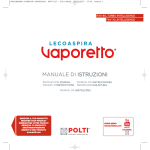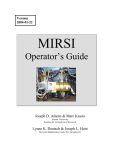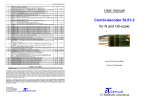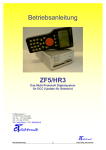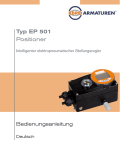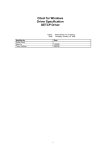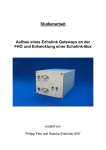Download User Manual Sound decoder GE70 Suitable for N – I
Transcript
User Manual Sound decoder GE70 Suitable for N – I scale 21x14x5mm 0.85 x 0.55 x 0.2 inch (L x W x H) www.tran.at 2 Sounddecoder GE70 INHALT 1. 2. 2.1. 3. 4. 4.1. 5. 5.1. 5.2. 5.3. 5.4. 6. 7. 8. 8.1. 8.2. Overview..................................................................................... 3 Technical specifications.............................................................. 4 Connection diagram....................................................................4 Safety instructions ...................................................................... 5 Connections................................................................................ 6 Connection diagram for steam loco............................................6 Programming and taking into use............................................... 7 Basic functionality .......................................................................7 “Hard reset“.................................................................................8 CV29 remarks.............................................................................8 Support for Roco Lokmaus.........................................................9 Configuration Variables description (CV’s) ............................... 10 Sound file structure (File list) .................................................... 15 Calculation of the CV values..................................................... 18 Transferring binary values into decimal ....................................18 Windows calculator...................................................................19 Pictures Picture 1 Connection diagram..................................................................... 4 Picture 2 Connection standard speaker (50 Ohm)...................................... 6 Picture 3 Connection of a low impedance speaker (8 Ohm) ...................... 6 Picture 4 Windows calculator binary ......................................................... 19 Picture 5 Windows calculator decimal. ..................................................... 19 Tables Table 1 Technical specifications ................................................................. 4 Table 2 CV Table ...................................................................................... 14 Table 3 File list .......................................................................................... 17 Table 4 Calculation Table ......................................................................... 18 Table 5 Calculation example..................................................................... 18 www.tran.at Ausgabe 02.10.2004 Sounddecoder GE70 1. 3 Overview The GE70 sound decoder is suitable for all digital model railroad systems using the DCC standard. It offers 3 simultaneous (3 channels) playable sound data’s that can be freely linked to one of the function keys. Full function mapping conforming to NMRA standards is supported. F1 is reserved for sound on/off, but can also be remapped. Depending on the application the same decoder can be loaded with diesel, steam or E-loco sounds. With the SoundProg it is possible to load sounds in built-in situation (decoder does not need to be removed from the model). There is no limitation on the number of re-loads. The number of exhausts per wheel revolution when loaded with steam sounds can be set anytime with CV49. CV49 Bit 0 = 1 reed switch for impulses is activated. CV51 is then the number of impulses per steam burst. CV51 = 10 10 revolutions per steam burst. Using the file list a sound structure is built. In the file list a sound structure is built by adding sound by groups. It is mandatory to use the order of the sounds, the bold marked items represent a sound group (also called Slot). It is however not necessary to fill all possible entries. Total size of all sounds together is limited to 2 MBit (Extended explanation to be found in the user manual if the SoundProg). The decoder supports full NMRA addressing, 14/28 and 128 speed steps for speed depending sounds. For steam locomotives the possibility exists to synchronise the sounds with the wheel revolutions (Reed switch). Frequency of the sounds is speed dependant and can be changed by means of setting CV53 and CV54 The GE70 is fully NMRA compatible and can therefore be used in alle digital systems who use the NMRA DCC Data format, like Digitrax, Lenz, LGB, Uhlenbrock, Zimo, Roco ‘digital is cool’, etc. Standard GE 70: 1W Nominal speaker power. Synchronisation connections for Reed or Hall switch. Type depending equipped with 4 (E-loco, diesel) or 6 (steam loco) flexible wires. Version 12-03-2004 www.tran.at 4 Sounddecoder GE70 2. Technical specifications An internal bridge rectifier supplies all outputs of the decoders. The total load is limited to 0.8A. Track voltage .............................................................................. 12-24V Nominal power .................................................................................. 1W Operating temperature......................................................... -10 to 90°C Dimensions ............(L x W x H) 0.85 x 0.55 x 0.2 inch / 21 x 14 x 5 mm Wiring length ................................................................ 6 inch / 150 mm Table 1 Technical specifications 2.1. Connection diagram Picture 1 Connection diagram The GE70 has no shrink tube off-factory. High flexible wire is used on all outputs. The audio amplifier has 1W nominal power. The connected speaker must have minimum impedance of 50 Ohm. Low impedance speaker (i.e. 8Ohm speakers) may not be directly connected. If an 8Ohm speaker is used: solder a resistance of about 40Ohm in one of the speaker leads (see picture 3). www.tran.at Ausgabe 02.10.2004 Sounddecoder GE70 3. 5 Safety instructions The decoder outputs are not protected against short circuits. As well internal as external (i.e. short circuit on the speaker output. Wron connections as switching the connections of the track and speaker outputs or connection of any other incorrect power supply will damage the decoder making it potentially defect. . Usually decoders are not damaged by over current but due to voltage spikes caused by the motor or other inductive parts. Spikes generated by the motor can be in access of several hundreds of Volts. As a countermeasure circuits have been built in the decoder to cope with these spikes. Please note however that these circuits have their limitation with respect to response time and voltage limits. Therefore do not set a to high voltage on your central unit or booster then necessary (max. nominal voltage 12-24V). For H0 and N scale one should set about 16V. A secondary reason to do so is to protect the light bulbs in your models, which will last longer when supplied with a lower voltage. Due to small parts not suitable for children under 3 years of age. No liability and responsibility is accepted on errors, changes of technical specs and materials. No liability is taken on all damage or resulting damage thereof due to improper handling and use, defective appliances, any changes performed by user interference, overload or overheat resulting from use outside of specifications. Use of the decoder with appliances not meant for model railroads is strictly excluded from any liability and warranty. Mount the decoder with double-sided tape. Under no circumstance there should be contact between any part of the decoder and loco housing or any other metal part. Isolate all metal parts in the surrounding area of the decoder with plastic tape to avoid short circuit. Never wrap the decoder in shrink tube or isolation tape. This will reduce air circulation and will damage the decoder. When touching the decoder under operation hardand/or software might be damaged. Warranty will be void when used in an improper manner or use outside of specifications. Version 12-03-2004 www.tran.at 6 4. Sounddecoder GE70 Connections All connections must be potential free meaning all must be isolated against wheel pickups and metal housing. All condensators and / or coils must be removed from the electrical motor connections before you connect the decoder. No form of filters whatsoever should be connected to the motor. 4.1. Connection diagram for steam loco braun violett Decoder Reedschalter braun grün Schiene links Schiene rechts schwarz rot Picture 2 Connection of a standard speaker (50Ohm) braun violett Decoder Reedschalter braun grün schwarz rot 40E Schiene links Schiene rechts Picture 3 Connection of a low impedance speaker (8Ohm) In case of a diesel or E-Loco decoder, the brown wires are not mounted. Also can steam loco decoders be used without synchronisation. www.tran.at Ausgabe 02.10.2004 Sounddecoder GE70 5. 7 Programming and taking into use All of the sound decoders have address 3 set by default out of the box (you can use or test the decoder immediately using this address). It is recommended you test the decoder at its final address and with final settings before you start using it on your layout. It is recommended that the speaker is not connected during programming. During reading and writing an acknowledgement pulse is fed back to your central unit or other programming device. This causes a short current feedback, which will be recognised by the central unit and will acknowledge a properly handled operation. In case this current feedback is too high or low, the central unit will not acknowledge the read or write operation as proper (although the value as such can be properly set in the decoder!). Should this happen disconnect the speaker. For the reading and writing procedure, please check the manual of your digital system. 5.1. Basic functionality The sound decoder is set and addressed at the same address as the loco decoder. It reads therefore the same commands that are sent by the central unit and consequently emits the sound belonging to the requested mode of operation. Programming is done separately from programming the loco decoder. Some of the CV’s have the same functionality as those from the loco decoder and will, when used in the same loco, have the same setting. I.e. address and de-/acceleration curves. Most of the other CV’s have a totally different function in the GE70 if compared to a loco decoder. Therefore they have to be programmed separately avoiding mix up of settings in both of the decoders. After parameter setting of the GE70, by means of writing value 88 in CV99 further (accidental) writing can be blocked. You can then write the requested values in the loco decoder without having to disconnect or disassemble the GE70. Version 12-03-2004 www.tran.at 8 Sounddecoder GE70 Besides the standard available CV’s according to NMRA-Norm there are quite a few specific settings available in the GE70. The allowed min and max values differ from CV to CV. Please make sure you read the CV explanation before attempting the program this decoder. All CV’s of the GE70 are explained in chapter 6. Programming in built-in situation: To make it possible to program the decoder without reprogramming the loco decoder at the same time, the GE70 offers the possibility to program them separately when built-in and connected. First the to be programmed CV number is written in CV7. Then write the required value for this CV in CV8. I.e. if you want to write the value of 32 in CV49: First set value 49 in CV7. Then write value 32 in CV8. By means of this programming method it is prevented that any value in the loco decoder is changed because CV 7 and 8 can, in the loco decoder, not be written but are read-only. 5.2. “Hard reset“ If the address in CV1 is set to “0“ a hard reset will be executed with which all Configuration Variables will be set to their default values. The free speed table in CV67-94 is also reset. The decoder can be regarded after a hard reset as a brand new one straight from the box. During the hard reset sequence the decoder emits a high frequency beep (off course with speaker connected!) at the start of the reset and a low frequency beep at the end of the sequence. 5.3. CV29 remarks The GE70 uses in CV29 more bits for the set up of decoder characteristics if compared to other manufacturers. Bits 3, 6 and 7 are mostly not used in those cases. Please keep this in mind when you use CV values from other decoders. www.tran.at Ausgabe 02.10.2004 Sounddecoder GE70 5.4. 9 Support for Roco Lokmaus The Roco Lokmaus System supports a value range of 2 digits (0-99). This makes writing in CV’s of values > 99 not directly possible. The GE70 sound decoder offers a workaround for this. When CV99 contains a value of 1 then in all afterwards written CV’s the value of 100 will be added. If CV99 = 2 then a value of 200 will be added. P.S. for to be written values in the range of 0-99 do not forget to write a value of 0 in CV99! Users of digital systems supporting more then 2 digits can directly program all CV’s. This programming method works on all CV’s except on the decoder address. A value above 99 would make the decoder inaccessible for Lokmaus users. Version 12-03-2004 www.tran.at 10 6. Sounddecoder GE70 Configuration Variables description (CV’s) CV Description Decoder address: this is the number by which 1 the loco is addressed by the digital system. Valid when CV29 Bit 5 is set to 0. 2 Start voltage: not used Acceleration curve: defines the curve at which 3 the loco goes from idle to full speed. Deceleration curve: defines the curve at which 4 the loco goes from full speed to idle. 5 Maximum speed: not used Middle speed: combined with CV2 and 5 a 36 point speed curve can be defined. If CV6 = 0 --> linear curve. Valid only when CV 29 Bit 4 = 0. Version: read-only. Fixed factory stored firmware 7 version. Also check: „Programming in built-in situation“ Manufacturer ID: read-only. 117 = CT Elektronik 8 Also check: „Programming in built-in situation“ Bit mask for endless manual sounds: Only works when CV49 Bit 5 is set. 10 Bit 0 for sound 1, Bit 1 for sound 2, …etc….Bit 6 for sound 7 17 Extended address (long address): only active + when CV 29 Bit 5 is set to 1. 18 Consists address: offers second address to 19 control multiple loco “behind” one common address. www.tran.at Default Range 3 1 - 127 0 0 1 1 0 - 255 0 - 255 0 0 0 0 - 255 - variabel - 117 0 255 0 12810240 0 1-127 Ausgabe 02.10.2004 Sounddecoder GE70 11 Configuration bits: settings for several features. Bit 0 – motor direction: 0 = normal 1 = reversed Bit 1 – speed steps: 0 = 14, 1 = 28 (Bit 2 - power: 0 = only digital commands) (1 = analog and digital) Bit 3 - Loco identification impulse: 0 = off, 1 = on 29 Bit 4 – Speed characteristics: 0 = Default curve as in CV 2, 5, 6 0 1 = free table as in CV 67 - 94 Bit 5 – Address range: 0 = 1-127 as set in CV 1 1 = 128 - 10240 as set in CV 17 + 18 Attention: compared with other manufacturers the GE70 uses more bits in CV29 and CV49. Bit calculation for CV 29 Bit 0: 0 or 1 Bit 1: 0 or 2 Bit 2: 0 or 4 Bit 3: 0 or 8 Bit 4: 0 or 16 Bit 5: 0 or 32 Bit 6: 0 or 64 Bit 7: 0 or 128 0 30 Error analysis: not used Function mapping: conforming with NMRA 350, 1 specifications (calculation as in CV 29) 42 CV35-42 = 0 Function disabled Version 12-03-2004 0 - 255 0 0 - 255 www.tran.at 12 Sounddecoder GE70 Basic sound definitions: settings for sound type, number of cylinders etc.… CV49 = 0 4 Cylinder Loco 49 50 51 52 53 54 55 56 57 58 59 Bit 0 = 1 Reed switch is used for synchronisation for steam loco Set CV51 = number of impulses per exhaust Bit 1 = 2 Diesel- or E-Loco Bit 2 = 4 2 Cylinder Loco Bit 3 = 8 3 Cylinder Loco Bit 4 = 16 no steam bursts during downhill (only idle sounds) Bit 5 = 32 converting of LGB-Impulses from F1 Bit 6 = 64 no sound during stop to drive (Whistle) Bit 7 = 128 no sound during drive to idle (Breaking) Burst Base H: time between exhausts per speed step. Unit = 88µsec, (CV52*256 + CV51) / 252 Burst Base L: Time between two exhausts at speed step 1, (CV52*256 + CV51) * 88µsec Break sound: linked to internal speed curve, i.e. Value 20 break noise will be played at speed step 10. Frequency min: sound freq. In lower range. 128 = Original threshold, 255 = double freq., 64 = half freq. Frequency max: sound freq. In high range. 128 = Original threshold, 255 = double freq., 64 = half freq. Volume 0: Volume main sound (driving sound) 1 = low, 2 = medium, 3 = loud , F1 = sound on/off Volume 1: Bit 0 -1 manual function 1 : Bit 2-7 for number of repeats Volume 2: Bit 0 -1 manual function 2 : Bit 2-7 for number of repeats Volume 3: Bit 0 -1 manual function 3 : Bit 2-7 for number of repeats Volume 4: Bit 0 -1 manual function 4 : Bit 2-7 for number of repeats www.tran.at 0 0 - 255 50 100 0 - 255 0 - 255 0 0 - 255 64 0 - 255 180 0 - 255 3 1-3 11 1 - 255 6 1 - 255 10 1 - 255 10 1 - 255 Ausgabe 02.10.2004 Sounddecoder GE70 Volume 5: Bit 0 -1 manual function 5 : Bit 2-7 for number of repeats Volume 6: Bit 0 -1 manual function 6 : Bit 2-7 for 61 number of repeats Volume 7: Bit 0 -1 manual function 7 : Bit 2-7 for 62 number of repeats RAND_1: random generator for sounds during 63 idle RAND_2: random generator for sounds during 64 drive Free speed table / curve: active when Bit 4 in CV 29 is set to 1. 67Default values: 9,18,27,36,45,54,63,72,81,90,99, 94 108,117,126,135,144,153,162,171,180,189,198,2 07,216,225,234,243,252 Acceleration burst time: time at which there will still be heavy exhausts played after deceleration 96 (unit: 0,5 second. Applicable to sounds in memory location 00-03 of the sound file list). CV96 = 0 off Deceleration burst time: time at which there will be weak exhausts played after braking (unit: 0,5 97 second. Applicable to sounds in memory location 08-11 of the sound file list). CV97 = 0 off Random time: Minimum time between random 98 sounds (Unit: 0,5 second!) Special CV: for Roco Lokmaus users CV99 = 88 Reading and writing is disabled / blocked CV99 = 99 Reading and writing is enabled 60 99 1 13 10 1 - 255 10 1 - 255 10 1 - 255 255 0 - 255 255 0 - 255 --- 0-252 8 0-255 8 0-255 20 0-255 0 CV99 = 1 100 + value in chosen CV CV99 = 2 200 + value in chosen CV For Roco Lokmaus users: to be able to write values higher then 99. If CV99 = 1 or 2 then a value of 100 or 200 will be added to the value written in 1 the programmed CV. Users of central units allowing full value range do not have to use this work around. 0-255 I.e.: CV 50 should be written with value 167: First write 1 in CV99 then write 67 in CV50. Because of the value of 1 in CV99 a value of 167 will automatically be written in CV50. Version 12-03-2004 www.tran.at 14 Sounddecoder GE70 User CV: can freely be written and read. Does not 0 influence decoder characteristics. User CV: can freely be written and read. Does not 106 0 influence decoder characteristics. 105 0-255 0-255 Table 2 CV Table In chapter 8 the calculation method of the CV’s is explained step by step. CV 105 / 106 gives the possibility to set, for instance, the purchase date, owner data and such in the decoder. By reading this value, without the need to disassemble your model, you can extract that at any time. CV56-CV62: Bit 0 and 1 define the volume of the additional sounds controlled by F2-F8. Bit 2 to 7 define the number of repeats of the single sounds. The CV value is to be calculated as follows: Volume + (4 * repeat value) www.tran.at Ausgabe 02.10.2004 Sounddecoder GE70 7. 15 Sound file structure (File list) The marked sounds „* “ are played endless depending on mode of operation i.e. idle and driving sounds. Function keys can activate the other manual sounds. These manual sounds will be repeated as long as the function key is kept activated. Every “chapter” in the file list represents a sound group (Slot). Off course not all entries in a group must be filled with separate sounds. All manual sounds can be assigned to function keys as per NMRA function mapping CV35-CV42. Drive sound during deceleration * 00: TAKT1-F.WAV 01: TAKT2-F.WAV 02: TAKT3-F.WAV 03: TAKT4-F.WAV Drive sound constant pace * 04: TAKT1-m.WAV 05: TAKT2-m.WAV 06: TAKT3-m.WAV 07: TAKT4-m.WAV Drive sound during deceleration * 08: TAKT1-A.WAV 09: TAKT2-A.WAV 10: TAKT3-A.WAV 11: TAKT4-A.WAV Pause filler 0 - 3 (sound in between exhausts)) 12: SIL.WAV Pause filler 4 - 7 (sound in between exhausts) 13: SIL.WAV Pause filler 8 - 11 (sound in between exhausts) 14: SIL.WAV Starting sound (transfer from "sound off" to "idle") 15: INJEKTOR.WAV 16: --17: --Sound stop (transfer from "idle" to "sound off") 18: DAMPFAB.WAV 19: --20: --Sound during transfer idle – drive 21: HUPE.WAV 22: --23: --Additional sound during transfer idle - drive (on channel 2) 24: ANSAGE1.WAV 25: --26: --- Version 12-03-2004 www.tran.at 16 Sounddecoder GE70 Sound during transfer Drive-> Idle 27: BREMSEN.WAV 28: --29: --Additional sound during transfer Drive -> Idle (on channel 2) 30: ANSAGE2.WAV 31: --32: --Idle sound * 33: SIL.WAV 34: --35: --36: --manual sound 1 37: --38: --39: --40: --41: --manual sound 2 42: INJEKTOR.WAV 43: --44: --45: --46: --manual sound 3 47: PFIFF.WAV 48: --49: --50: --51: --manual sound 4 52: PUMPE.WAV 53: --54: --55: --56: --manual sound 5 57: SCHAUFEL.WAV 58: --59: --60: --61: --manual sound 6 62: GLOCKE.WAV 63: --64: --65: --66: --- www.tran.at Ausgabe 02.10.2004 Sounddecoder GE70 17 manual sound 7 67: DAMPFAB.WAV 68: --69: --70: --71: --Reserved, currently not used! 72: -=73: --74: --75: --76: --Reserved, currently not used! 77: --78: --79: --80: --81: --82: --83: --84: --85: --86: --- Table 3 File list Version 12-03-2004 www.tran.at 18 Sounddecoder GE70 8. Calculation of the CV values In the decoder memory several parameters can be set or switched on / off. In order to keep an easy overview and in line with internal memory allocations, functions belonging together or having influence at the same function are grouped together in Configuration Variables like CV29, CV 3342, CV 57 and CV 58. Every value in a CV, which consists of 8 separate values, which you can see as a toggle switch, can be set. Only a value of 0 or 1 is allowed. This is basically referred to as binary system. When written in a row, you will get 8 values consisting of either 0 or 1. This binary value needs to be converted to our normally used decimal system which value can then be written in the requested CV. 8.1. Transferring binary values into decimal The next table helps you in recalculating binary into decimal numbers Position / Bit Value Bit Setting Value 7 128 6 64 5 32 4 16 3 8 2 4 1 2 0 1 Table 4 Calculation Table Mark each bit to be set to 1 with x (value corresponding with the requested functionality). Mark the corresponding decimal value in lower row. Add the values in the most right column. This value can be written in the CV. Example: We will calculate CV 29. Normal direction, 28 speed steps, only digital commands, free speed table, long addresses and 16kHz Motor PWM. Position / Bit 7 6 5 4 3 2 1 0 Value 128 64 32 16 8 4 2 1 Bit setting x x x x Value (add) 128 32 16 2 178 • • • Table 5 Calculation example Mark the bit to be set to 1 with x. Write the corresponding value in lower row. 128 for Bit 7, 32 for Bit 5 etc. Add the values horizontally. The sum of 128 + 32 + 16 + 2 is the value to be written in the CV, which is 178. www.tran.at Ausgabe 02.10.2004 Sounddecoder GE70 8.2. 19 Windows calculator It is also quite convenient to use the Windows calculator for converting the values. This calculator has a scientific mode in which you can set binary and decimal set up. First set to binary. Key in the requested bit setting, i.e. „10110010“: Picture 4 Windows Calculator Binary Then set to decimal. You will then get the decimal converted number: Picture 5 Windows Calculator Decimal Grillparzergasse 5 A-2700 Wiener Neustadt Tel. Fax : +43 2622 82086 Tel.: +43 664 4719963 http://www.tran.at e-mail: [email protected] Version 12-03-2004 www.tran.at





















